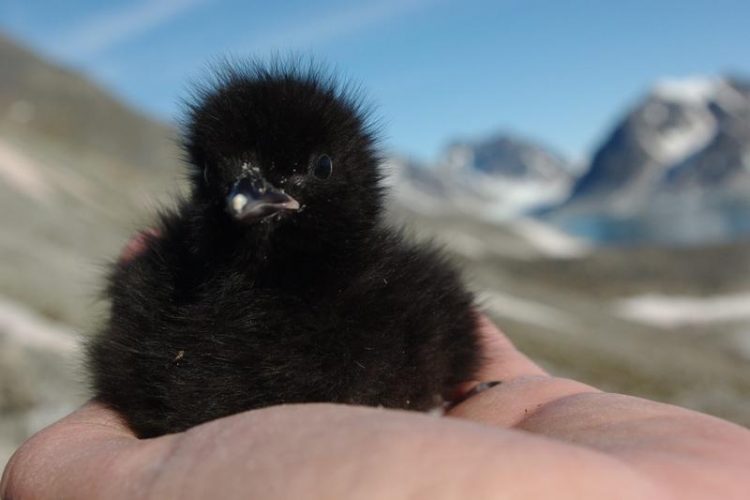Stressed seabird parents think only of themselves

Little auk chicks intensify begging for food when feeling stressed. The success of this strategy however depends upon their parents not being stressed themselves. Dorota Kidawa
Little auks (Alle alle) breed in large colonies on rocky cliffsides in arctic regions. These seabirds live in a harsh environment and often face stress in the form of food shortages and poor weather conditions. But this isn’t the only thing that makes them so suitable to study stress-induced behavioural mechanisms.
They also are of interest for their long lifespan and because little auks raise only a single chick during the year, which excludes sibling rivalry as a factor in stress studies. A team of researchers from Vetmeduni Vienna and the University of Gdansk in Poland thus attained informative insights into the interaction between long-lived birds and their offspring.
Stress behaviour in birds controlled by hormones
“Birds respond to stressful situations by releasing the hormone corticosterone,” explains senior author Rupert Palme from the Department of Physiology, Pathophysiology and Experimental Endocrinology at Vetmeduni Vienna. This makes corticosterone an important stress indicator in behavioural studies. Hormone pellets can be used to artificially release corticosterone into the birds’ bloodstream in order to observe the animals’ behaviour under stress.
The pellets have the advantage that corticosterone is released in a controlled fashion continuously over a certain period of time. An analysis of faecal samples can be used to show that the additional hormone was metabolised by the body. The internationally recognised method of measuring faecal hormone metabolites was developed by senior author Palme.
To analyse the mechanisms controlling familiar interactions among little auks, the researchers first implanted offspring birds, then parents with hormone-releasing pellets. Chick behaviour was analysed using acoustic recordings, that of the parents by looking at feeding intervals and time spent away from the nest or colony.
Little auk offspring come in second place
Nestlings responded to the artificially heightened stress levels by increasing their begging performance. “More food means more reserves, better fitness and, therefore, a higher chance of survival,” says first author Dorota Kidawa from the University of Gdansk, Poland. “The intensified begging behaviour was a cry for help directed at the parent birds that was clearly successful.” The stressed offspring weighed more than the control chicks, which indicates that they had been fed more frequently by the parent birds. “Our study shows that adult little auks usually go to their limit, to their caring maximum, in order to give their offspring enough to eat,” says Palme.
The second test, however, in which the researchers implanted a hormone pellet into one of the parent birds, showed that this limit depends on the stress level of the parent bird and not on the begging behaviour of the young little auks. Under stress, parent birds alter their behaviour to their own benefit. They left the nest for longer periods of time to provide more food for themselves. As a result, they fed their young less frequently and the physical state of the offspring worsened considerably compared to the control group.
Despite egoistic survival instinct, the birds are not bad parents
“The begging behaviour elicited a care response among the adult little auks. But this response, and its extent, depend on how fit the parent birds feel,” says Palme. If their own chance of survival is reduced because of a food shortage or weather conditions, they will focus more on themselves and spend more time looking for their own food than on the care of their only chick.
“But that doesn’t make them bad parents,” says Palme. “This is a normal occurrence in nature that cannot be compared to our behaviour and sense of responsibility.” For the long-lived little auks, it is more important to secure their own existence, to survive another year and to raise another offspring in the future. After all, poor food conditions and environmental factors can also reduce the young birds’ chance of survival.
Service:
The article “Parent-offspring interactions in a long-lived seabird, the Little Auk (Alle alle): begging and provisioning under simulated stress“ by D. Kidawa, M. Barcikowski and R. Palme was published in Journal of Ornithology. DOI: 10.1007/s10336-016-1382-y
http://link.springer.com/article/10.1007%2Fs10336-016-1382-y
About the University of Veterinary Medicine, Vienna
The University of Veterinary Medicine, Vienna in Austria is one of the leading academic and research institutions in the field of Veterinary Sciences in Europe. About 1,300 employees and 2,300 students work on the campus in the north of Vienna which also houses five university clinics and various research sites. Outside of Vienna the university operates Teaching and Research Farms. http://www.vetmeduni.ac.at
Scientific Contact:
Rupert Palme
Unit of Physiology, Pathophysiology, and Experimental Endocrinology
University of Veterinary Medicine Vienna (Vetmeduni Vienna)
T +43 1 25077-4103
rupert.palme@vetmeduni.ac.at
and
Dorota Kidawa
University of Gdansk, Poland
dokdki@univ.gda.pl
Released by:
Georg Mair
Science Communication / Corporate Communications
University of Veterinary Medicine Vienna (Vetmeduni Vienna)
T +43 1 25077-1165
georg.mair@vetmeduni.ac.at
http://www.vetmeduni.ac.at/en/infoservice/presseinformation/press-releases-2017/…
Media Contact
All latest news from the category: Life Sciences and Chemistry
Articles and reports from the Life Sciences and chemistry area deal with applied and basic research into modern biology, chemistry and human medicine.
Valuable information can be found on a range of life sciences fields including bacteriology, biochemistry, bionics, bioinformatics, biophysics, biotechnology, genetics, geobotany, human biology, marine biology, microbiology, molecular biology, cellular biology, zoology, bioinorganic chemistry, microchemistry and environmental chemistry.
Newest articles

Properties of new materials for microchips
… can now be measured well. Reseachers of Delft University of Technology demonstrated measuring performance properties of ultrathin silicon membranes. Making ever smaller and more powerful chips requires new ultrathin…

Floating solar’s potential
… to support sustainable development by addressing climate, water, and energy goals holistically. A new study published this week in Nature Energy raises the potential for floating solar photovoltaics (FPV)…

Skyrmions move at record speeds
… a step towards the computing of the future. An international research team led by scientists from the CNRS1 has discovered that the magnetic nanobubbles2 known as skyrmions can be…





















